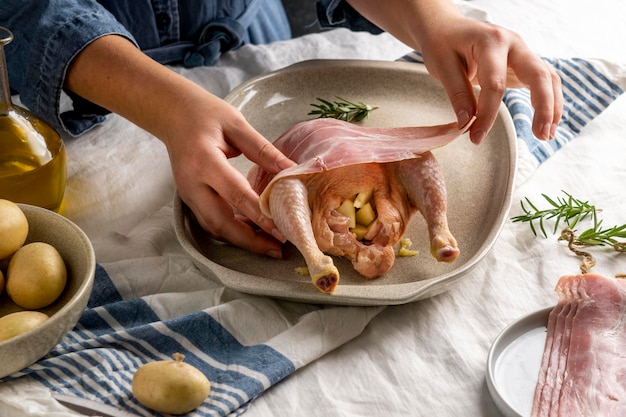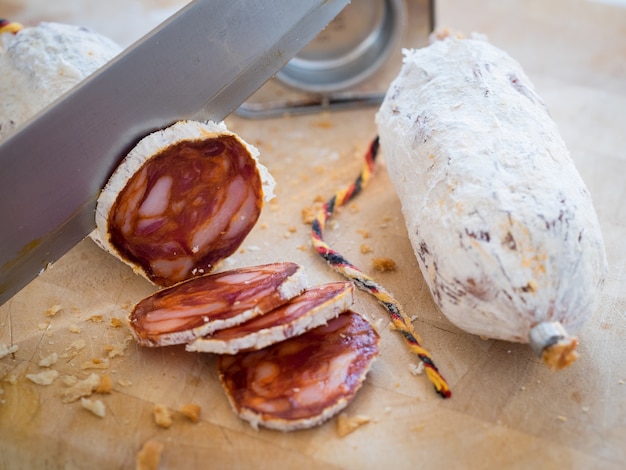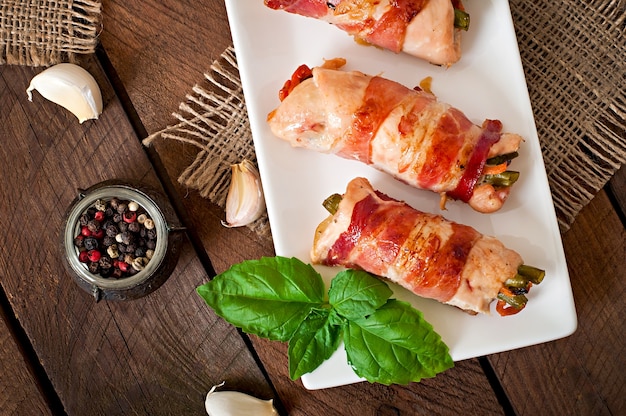spiral ham. Just the name conjures up images of festive gatherings, family feasts, and mouthwatering aromas. It's a true crowd-pleaser, but let's face it, cooking it to perfection can feel a bit daunting. I've been there, battling with overcooked, dry, or undercooked ham disasters. But over time, I've learned the ins and outs of spiral ham oven cooking, and I'm here to share my wisdom with you.
This guide will be your ultimate companion, covering everything from selecting the perfect ham to achieving that irresistible golden-brown glaze. So grab a cuppa, put on your comfy slippers, and let's dive into the world of spiral ham together!
(Part 1) Choosing the Right Ham: A culinary adventure

The first step to a truly delicious spiral ham is choosing the right one. It might seem like a simple task, but trust me, there's a bit more to it than grabbing the first ham you see.
1.1 Types of Spiral Ham: Bone-in or Boneless?
Spiral ham usually comes in two main varieties: bone-in and boneless. Personally, I'm a big fan of bone-in ham. It feels more traditional, and the bone adds a lovely depth of flavor to the dish. You know, that "real ham" taste that makes you feel like you're at a proper feast. boneless ham, on the other hand, is great for convenience. It's easier to carve and doesn't require any extra work removing bones. It's perfect if you're short on time or want a fuss-free option.
1.2 Fresh or Cured: The Ham Debate
Another important consideration is whether you want fresh or cured ham. Cured ham is what you'll typically find in the grocery store. It's already cooked, so all you need to do is heat it up and enjoy. fresh ham, however, needs to be cooked before you can devour it. Now, I'm a traditionalist at heart, so I usually go for cured ham. I like the convenience, and it tastes just as good as fresh ham.
1.3 Size and Weight: Feeding the Crowd
The size of the ham you choose will depend on how many hungry mouths you need to feed. For a small gathering, a 4-6 pound ham will do the trick. But if you're expecting a crowd of friends and family, you'll want to go for something bigger, maybe an 8-10 pound behemoth. Remember, you can always freeze any leftovers for later use. That's what I do when I've overestimated my needs (happens more than I care to admit).
1.4 Look for the Label: "Fully Cooked" is Key
When choosing a ham, it's crucial to pay attention to the label. Look for hams that are "fully cooked" or "ready to eat." This means they've been cooked to a safe internal temperature, ensuring that it's safe to eat right out of the package. You'll be ready to indulge in your delicious ham without any worries.
(Part 2) Preparation: Getting the Ham Ready

Now that you've chosen the perfect ham, it's time to get it ready for its grand entrance into the oven. This step might seem like a simple formality, but it's important for ensuring your ham cooks evenly and absorbs the flavors of your glaze.
2.1 Removing the Packaging: Unveiling the Ham
First, you'll need to remove the ham from its packaging. If it's in plastic wrap, you can simply discard it. However, if it's wrapped in netting, you'll need to remove that too. You can use a sharp knife to cut it off or gently pull it off. Just be careful not to snag the ham's skin.
2.2 Scoring the Ham: A Culinary Trick
Here's a little trick I learned from my grandmother: scoring the ham helps the glaze to penetrate the meat and creates a beautiful crispy crust. You can score the ham by making diagonal cuts about 1/2 inch apart across the surface of the ham. It's easy to do, and it makes a real difference in the final result.
2.3 Adding the Glaze: The First Layer of Flavor
You can use your favorite ham glaze or try a simple homemade one. I've got a recipe for a sweet and smoky glaze that I'll share later in the guide. But for now, just apply a thin layer of glaze over the entire surface of the ham. This initial layer helps the glaze meld with the ham during cooking, creating a more intense flavor.
(Part 3) Cooking the Ham in the Oven: The Grand Finale

Alright, now comes the fun part – the actual cooking process! This is where the magic happens, where your spiral ham transforms from a raw cut of meat into a feast-worthy centerpiece.
3.1 Preheat Your Oven: Setting the Stage
First, preheat your oven to 325°F (160°C). You want the oven nice and hot to ensure the ham cooks evenly and doesn't dry out. This is a crucial step, so don't skip it!
3.2 Place the Ham in a roasting pan: The Ham's Home
Next, place the ham in a roasting pan. I prefer using a pan with a rack to allow for air circulation and even cooking. You don't need to add any water to the pan, the ham will release enough moisture during cooking.
3.3 Cover the Ham with Foil: Trapping the Moisture
Now, cover the ham loosely with aluminum foil. This will help to trap the moisture and prevent the ham from drying out. Remember, a moist ham is a tender ham!
3.4 Calculate the Cooking Time: Timing is Everything
The cooking time for spiral ham depends on its size and weight. Here's a general guideline:
| Weight of Ham (pounds) | Cooking Time (hours) |
|---|---|
| 4-6 | 1-1.5 |
| 6-8 | 1.5-2 |
| 8-10 | 2-2.5 |
This is just a rough estimate, and you'll need to adjust the cooking time based on your oven and the specific ham you're using. It's always better to err on the side of caution and check the temperature frequently.
(Part 4) Checking the Ham's Temperature: The Safety Check
One of the most important things when cooking spiral ham is ensuring it reaches the safe internal temperature. You'll need to use a meat thermometer to check this. Don't worry, it's a simple process.
4.1 Insert the Thermometer: Finding the Core
Insert the thermometer into the thickest part of the ham, making sure it doesn't touch the bone. The bone can affect the temperature reading, so ensure you get a reading from the actual meat.
4.2 The Safe Internal Temperature: Aim for Perfection
The ham is cooked when it reaches an internal temperature of 140°F (60°C). It's important to cook the ham to this temperature to ensure it's safe to eat.
4.3 Don't Overcook the Ham: A Tender Ham is a Happy Ham
Overcooking the ham can lead to a dry, tough, and unappetizing dish. So, make sure you remove it from the oven as soon as it reaches the safe internal temperature. It's better to err on the side of slightly undercooked than overcooked.
(Part 5) Glazing the Ham: The Final Touches
Once the ham has reached the safe internal temperature, it's time to glaze it! This is the step that really takes the ham to the next level, transforming it from a simple roast to a culinary masterpiece.
5.1 Remove the Foil: Revealing the Beauty
First, remove the aluminum foil from the ham. This will allow the glaze to caramelize and create a delicious, crispy crust. You'll be able to see the ham's beautiful golden-brown color, tempting everyone with its irresistible aroma.
5.2 Apply the Glaze: A Sweet Symphony
Now, brush the ham with the glaze. You can use a pastry brush or a spoon to apply it evenly. Make sure to coat the entire surface of the ham for a truly magnificent glaze.
5.3 Broil the Ham: The Final Glow
For a beautiful golden-brown glaze, place the ham under the broiler for a few minutes, keeping a close eye on it to prevent burning. This final step gives the glaze that extra sparkle and adds a layer of caramelization, creating a truly decadent treat.
(Part 6) Resting the Ham: A Moment of Patience
After cooking and glazing, it's essential to let the ham rest for about 15-20 minutes before carving it. This allows the juices to redistribute throughout the meat, resulting in a more tender and flavorful ham.
6.1 Cover the Ham: Keeping it Warm
While the ham is resting, cover it with a piece of aluminum foil to keep it warm and moist. This will prevent the ham from drying out during the resting period.
6.2 Slice the Ham: A Culinary Triumph
Once the ham has rested, you can slice it and serve it. I like to slice the ham thinly to ensure each slice is evenly cooked and tender. It's a real delight to carve and see those beautiful slices of ham.
(Part 7) Glaze Recipes: Sweeten the Deal
Now, let's talk about some amazing glaze recipes that will take your spiral ham to a whole new level of deliciousness! It's all about finding the right flavor combination to complement the ham and create a truly unique taste experience.
7.1 Sweet and Smoky Glaze: A Classic Combination
This glaze is my personal favorite. It's sweet, smoky, and just a little bit tangy. Here's what you'll need:
- 1/2 cup brown sugar
- 1/4 cup honey
- 1/4 cup apple cider vinegar
- 1 tablespoon Dijon mustard
- 1 teaspoon smoked paprika
- 1/2 teaspoon black pepper
To make the glaze, simply combine all the ingredients in a saucepan over medium heat. Bring the mixture to a simmer, stirring constantly, until the sugar is dissolved and the glaze is thickened. You can adjust the sweetness and smokiness to your liking.
7.2 Maple Pecan Glaze: A Touch of Luxury
If you're looking for something a bit more decadent, this maple pecan glaze is for you. It's rich, nutty, and incredibly flavorful.
- 1/2 cup maple syrup
- 1/4 cup chopped pecans
- 1 tablespoon butter
- 1 teaspoon vanilla extract
- 1/4 teaspoon salt
Combine all the ingredients in a saucepan over medium heat. Stir until the butter is melted and the glaze is smooth. The maple syrup and pecans create a delightful combination of sweet and savory, perfect for a holiday feast.
7.3 pineapple glaze: A Tropical Delight
For a tropical twist, this pineapple glaze is a great choice. It's sweet, tangy, and perfect for pairing with ham.
- 1/2 cup pineapple juice
- 1/4 cup brown sugar
- 1 tablespoon cornstarch
- 1/4 teaspoon ground ginger
- 1/4 teaspoon ground cinnamon
Whisk the cornstarch with a little bit of the pineapple juice to make a slurry. Combine the remaining pineapple juice, brown sugar, ginger, and cinnamon in a saucepan over medium heat. Bring the mixture to a simmer, stirring constantly. Slowly whisk in the cornstarch slurry until the glaze thickens. This glaze is a refreshing change from traditional ham glazes.
(Part 8) Serving the Ham: The Grand Reveal
Alright, you've cooked your spiral ham to perfection, and it's time to serve it up. Now, this is the fun part, where you get to enjoy all your hard work!
8.1 Carving the Ham: A Culinary Art
When carving the ham, it's best to start from the thickest part and work your way towards the thinner end. You can use a sharp carving knife or a ham slicer for this. Carving the ham can be a bit of a performance, showcasing the beautiful golden-brown glaze and the succulent meat.
8.2 side dishes: A Symphony of Flavors
Spiral ham is perfect for pairing with a variety of side dishes. Some classic options include mashed potatoes, green beans, sweet potatoes, and cornbread. I also love serving it with a fruit salad for a refreshing contrast. You can create your own unique combinations based on your preferences and the occasion.
8.3 Enjoy Your Delicious Ham: The Moment of Truth
Finally, sit back, relax, and enjoy your delicious spiral ham! You've worked hard to make it, so savor every bite. It's the perfect moment to share with loved ones, creating memories that will last a lifetime.
(Part 9) FAQs: Addressing Your Culinary Concerns
You might have some questions about cooking spiral ham. Don't worry, I've got you covered.
9.1 Can I cook spiral ham in a slow cooker?
Absolutely! Slow cookers are a great way to cook spiral ham, especially if you're looking for a hands-off method. Simply place the ham in the slow cooker, cover it with a glaze, and cook on low for 4-6 hours or until it reaches an internal temperature of 140°F (60°C). The slow cooker method is perfect for those who want a tender and flavorful ham without having to constantly monitor the oven.
9.2 Can I Freeze Cooked Spiral Ham?
Yes, you can freeze cooked spiral ham. Wrap it tightly in plastic wrap and aluminum foil and store it in the freezer for up to 2 months. To thaw the ham, transfer it to the refrigerator and let it thaw for 24 hours. This is a great way to save leftovers for later use.
9.3 What Can I Do with Leftover Spiral Ham?
Leftover spiral ham is a great base for a variety of dishes! You can use it in sandwiches, salads, soups, or even pizza. You can also make ham and bean soup, ham and cheese quiche, or ham and potato hash. Get creative and experiment with different ways to use your leftover ham.
9.4 Can I Use a Different Glaze?
Absolutely! The beauty of spiral ham is that it's so versatile. You can use any glaze you like, from sweet and savory to spicy and tangy. You can even experiment with different flavors like brown sugar and mustard, honey and ginger, or pineapple and jalapeno. Don't be afraid to get creative and try new things!
9.5 Can I Cook a Bone-in Ham Like a Spiral Ham?
You can cook a bone-in ham in the oven, but it won't be the same as a spiral ham. The cooking time will be longer, and you'll need to check the internal temperature carefully. You can also use a roasting rack to help the ham cook evenly. If you're looking for the spiral ham experience, stick to a spiral ham.
So, there you have it! With this comprehensive guide, you'll be a spiral ham cooking pro in no time. Remember, the key is to choose the right ham, follow the instructions carefully, and most importantly, have fun with it! Now go forth and create a culinary masterpiece that will leave your family and friends raving!
Everyone is watching

How to Cook Frozen Lobster Tails Perfectly: A Step-by-Step Guide
RecipesLobster. Just the word conjures up images of lavish meals, special occasions, and a taste of luxury. But let's...

Pigs in a Blanket Cooking Time: How Long to Bake for Perfect Results
RecipesAh, pigs in a blanket. Just the name conjures up images of those delightful little parcels of crispy pastry en...

Pork Fillet Cooking Time: How Long to Cook It Perfectly
RecipesPork fillet, or tenderloin as it's sometimes called, is a real favourite in our house. It's so versatile, and...

The Ultimate Guide to Tender, Juicy Pulled Pork
RecipesRight, let's talk pulled pork. It's one of those dishes that just screams "comfort food," doesn't it? I mean...

The Ultimate Guide to Cooking Sweet Potatoes: From Roasting to Mashing
RecipesSweet potatoes. Just the name conjures up images of warm, comforting dishes, bursts of vibrant color, and a to...
